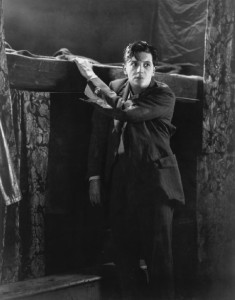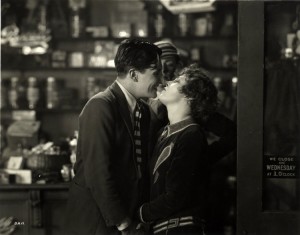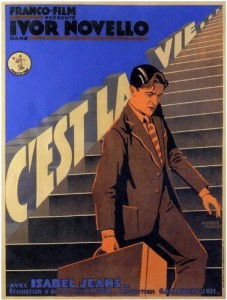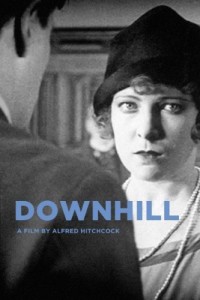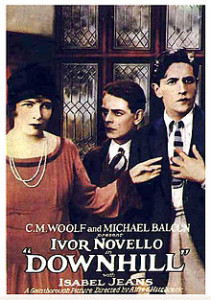Downhill *** (1927, Ivor Novello, Isabel Jeans, Robin Irvine, Ben Webster, Norman McKinnel) – Classic Movie Review 2286
Welsh actor and composer Ivor Novello stars as English boarding schoolboy Roddy Berwick, who is unjustly condemned for a sexual indiscretion after he takes the blame for a friend, in director Alfred Hitchcock’s 1927 silent film version of his own play.
Hitchcock’s fifth film as director, it was made by Gainsborough Pictures at their Islington studios. Novello co-wrote the play with Constance Collier under the amusing combined alias David L’Estrange (his real name was David).
School captain and star rugby player Roddy and his best friend Tim (Robin Irvine) start seeing waitress Mabel (Annette Benson), who tells the headmaster she is pregnant and that Roddy is the father. It was actually Tim, who cannot afford to be expelled because he needs to win a scholarship to attend Oxford University.
Promising Tim that he will never reveal the truth, Roddy allows himself to be expelled from school and promptly goes downhill terribly as his life falls apart in a series of misadventures. He becomes a chorus boy (!) in a theatre and marries the unfaithful leading actress Julia Fotheringale (Isabel Jeans), who discards Roddy when he runs out of money. He becomes a gigolo in a Paris music hall before ending up alone and delirious in a shabby room in Marseilles about to take a ship off to the British colonies.
Not surprisingly, Downhill is wildly dated but still a fascinating curiosity and study for fans of the star and director Hitchcock, who is developing his socio-sexual preoccupations and his Germanic visual style, playing with shadow and light in German Expressionist film style, on the way uphill to his true forte in thrillers. ‘It was a very poor play,’ said Hitchcock. ‘The film’s dialogue was pretty dreadful in spots.’
What’s important here is that Hitchcock’s emerging style is clearly shown in his use of a variety of screen techniques to tell the story with a minimum of title cards, to allow the film’s visual narrative tell the story. For example, Hitchcock uses shots of a descending escalator at Maida Vale Tube station as a visual metaphor for Roddy’s downhill descent and experiments with dream sequences by shooting them in super-impositions and blurred images.
Novello is credited with the screenplay and that dialogue, along with Eliot Stannard. Novello had just starred for Hitchcock in a much better film, the silent classic The Lodger (1927).
His longtime companion of 35 years, actor Robert Andrews, was with Novello when he died suddenly aged 58 on March 6 1951 of a coronary thrombosis only hours after performing in his own play The King’s Rhapsody. He is portrayed by Jeremy Northam in the largely fictional Gosford Park (2001).
The various memorials to Novello in London include a blue plaque in the Aldwych between the Novello Theatre and the Waldorf Hotel marking the entrance to the flat above the theatre where he lived until his death. His name lives on in the Ivor Novello Awards given out annually by the record industry to British publishers, composers and arrangers since 1956.
It was known in America by the rather curious title of When Boys Leave Home. The French version is called C’est La Vie, but why is anyone’s guess. Also in the cast are Ben Webster, Robin Irvine, Sybil Rhoda, Lilian Braithwaite, Ian Hunter, Hannah Jones, Violet Farebrother, Norman McKinnell, Jerrold Robertshaw, Annette Benson, Barbara Gott and Alfred Goddard.
The running time is 80 minutes, 0r 74 in America, but the restored 2012 film runs
The play had a short run in London’s West End and longer in the UK provinces. Novello thrilled his fans by washing his bare legs after the rugby match. Hitchcock includes a similar scene with Novello shirtless.
http://derekwinnert.com/the-lodger-a-story-of-the-london-fog-classic-film-review-274/
© Derek Winnert 2015 Classic Movie Review 2286
Check out more reviews on http://derekwinnert.com

